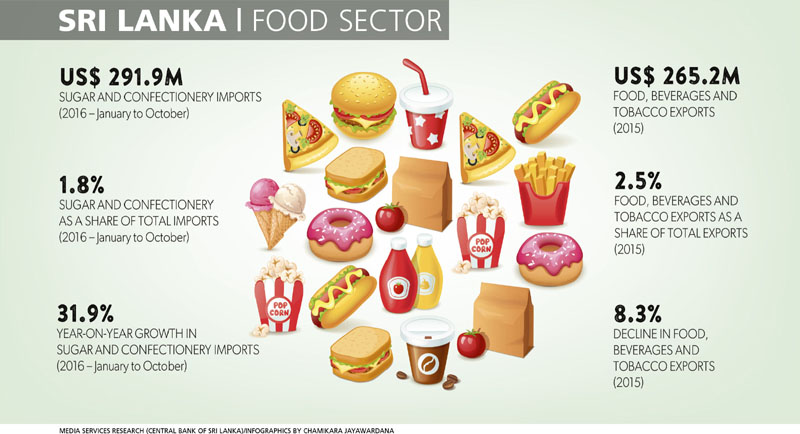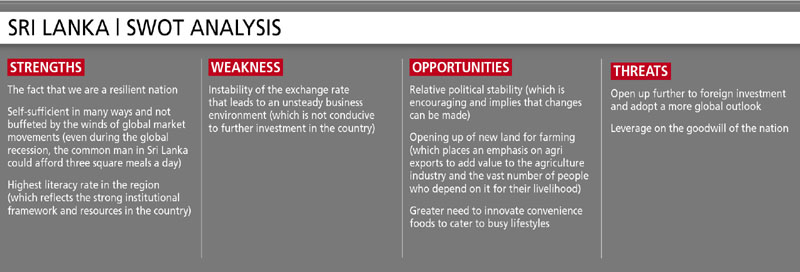CONFECTIONERY SECTOR
Compiled by Yamini Sequeira
BISCUITS NEED SWEETENERS
Kumudika Fernando mulls over the must-haves for the biscuit sector to grow

In her assessment of the domestic biscuit sector, the Managing Director of Maliban Group of Companies Kumudika Fernando notes: “According to Nielsen, the sector grew by 2.4 percent in 2016 and we expect the numbers to be much the same this year as well.”
“While this level may not be ideal, the sector has absorbed a cost increase recently due to the increased price of raw materials. This will hamper volume growth overall. But the next two years should be good for the sector and we hope to witness double-digit growth during this time,” she adds.
MARKET DYNAMICS In 2008, the country’s per capita biscuit consumption was in the region of four kilogrammes (kg) – much higher than India’s 1.1 kg and Indonesia’s 1.6 kg. At the time, biscuit consumption in Sri Lanka was pegged at slightly below 44,000 metric tonnes a year and its value at around Rs. 17.8 billion.
But today, annual biscuit consumption has increased to 81,000 metric tonnes and is valued at 36 billion rupees.
The biscuit sector is driven by external factors like rapid urbanisation, greater disposable incomes and busy lifestyles with people seeking food items that can quell hunger and energise them on the go.
Fernando asserts that “over the last year or so, there has been pressure on disposable incomes because of which people have stopped buying what they view as non-essential items; and unfortunately, biscuits and confectionery sales have suffered as this segment does not come under the ‘essentials’ list in many households.”

WELLNESS However, a notable trend in the sector has been the proliferation of health and wellness categories, as the demand for nutritious and tasty yet low-calorie products rises in the country.
Growing health consciousness among the urban population is inspiring local players to innovate with sugar-free and wholegrain products that meet wellness needs.
“While this segment of consumers may not be substantial, it represents a growing category that manufacturers cannot ignore. Moreover, consumers in this segment are willing to pay more for such products, implying that the ball is now in the court of manufacturers to come up with healthy options that can be marked up accordingly,” Maliban’s Managing Director avers.
A global industry market research report indicates that the inclination towards high-fibre food products is driving manufacturers to include fibrous and other nutritious ingredients in their products.
And as consumers evince an interest in premium products, manufacturers are introducing organic products by eliminating artificial flavours and preservatives, high fructose corn syrup (HFCS) and other such ingredients.

COMPETITION While most biscuit sales in Sri Lanka are seen at the general grocery ‘mom and pop’ stores, the expansion of the ‘supermarket culture’ is driving sales. Attractive packaging is a key component in driving biscuit sales and Sri Lanka does quite well in this regard as a visit to the supermarket would demonstrate.
It’s clear that manufacturers are sparing no effort to innovate in taste, ingredients, flavours, packaging, and the look and feel of products to lure consumers.
While biscuits and confectioneries are linked in Sri Lanka, this is not the case in developed nations where the consumption of the latter is high. In this country, chocolate consumption is still small albeit growing.
Fernando observes: “The positive factor in this is that when the price of chocolates increases, consumers tend to reach for biscuits.”
SENSITIVITIES But she maintains that interestingly, imported biscuit brands have not been able to carve out a large market share in Sri Lanka because they don’t appeal to the local palate.
Although consumers are known to be fickle, in this case, perhaps the loyalty and comfort factors – as well as the price-sensitive nature of consumers – have ensured that local brands rule the roost. It is Fernando’s wish that imports of biscuits to Sri Lanka should be on a negative list so that local brands have the room to grow without the market being flooded with foreign biscuits.
Advertising, marketing and promotion are key drivers of growth, and mass media is leveraged on aggressively to enhance brand visibility and spread awareness. Although there are over 40 players in the biscuit sector, two of the largest players account for a majority of the market.
CHALLENGES Commenting on the challenges the sector faces, Fernando explains that “the sector is price-sensitive but the only way that prices could be controlled would be if raw materials like sugar and coconut/palm oil were produced locally. The coconut oil produced locally is insufficient to meet demand, forcing manufacturers to import these basic products.”
She continues: “Lower duty on imported products would help the sector. It must be kept in mind that this sector is directly and indirectly employing about 50,000 people, which is substantial. Therefore, the authorities should ensure sustainability of the sector by offering incentives.”
STANDARDS The sector also has potential as a niche export for Sri Lanka. Leading players are exporting locally manufactured biscuits to countries and regions like the US, Europe, Australia, Africa and the Middle East, which affirms that they are on a par with the rest of the world.
The larger players are equipped with advanced manufacturing technology and machinery, strengthened by the adoption of globally accepted quality certifications that help secure export orders.

Internationally, Europe and North America are the leading markets for biscuits although the Asia-Pacific is expected to emerge as the mover and shaker in the coming years.
“We are proud of the fact that this sector has always been self-sufficient, and is manned by local engineering and manufacturing personnel. The sector has not needed any foreign know-how apart from importing machinery. This reflects the strength of human capital in this segment,” Fernando remarks.

In fact, a couple of large players have already established or are in the process of setting up operations overseas in the region to expand their businesses and cater to those markets. This is an encouraging development for the sector since the local market is fairly saturated. Biscuits enjoy a market penetration of 100 percent here in Sri Lanka!




